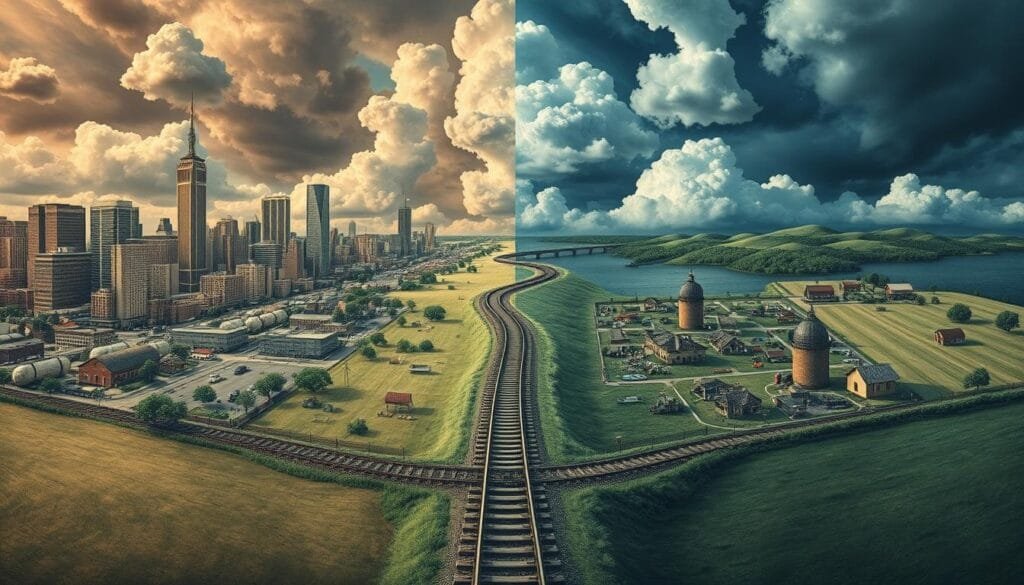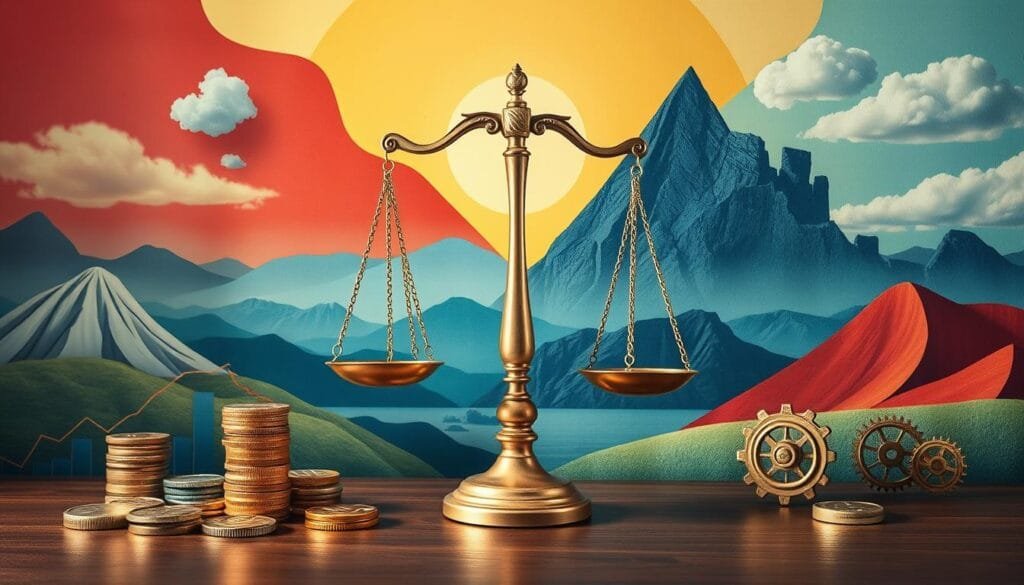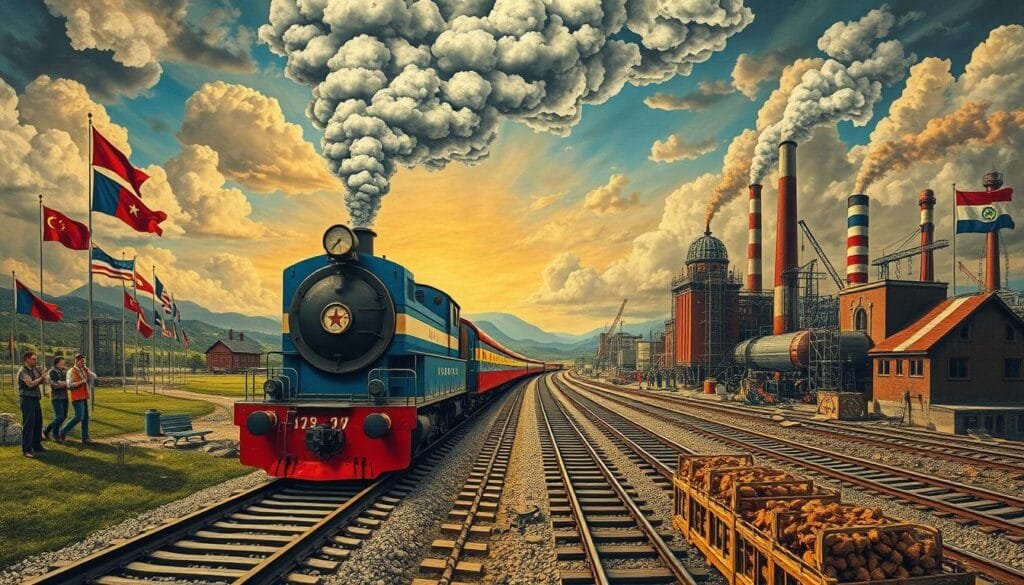Have you ever thought about how deep the gap is between political views? How does this divide shape our nation’s economic policies? The growing polarization in American politics affects not just our values. It also changes our economic strategies. This influences the market and how decisions are made. Let’s dive into the ‘Polarized Express.’ This term describes the economic divides caused by different ideologies between Democrats and Republicans. It shapes the economic world we live in every day.
In 2023, a big challenge for companies is to keep politics out of Environmental, Social, and Governance (ESG) topics. The move from caring only about shareholder profits to valuing all stakeholders was a big change in 2019. This was when 181 CEOs promised to care for everyone connected to their businesses. This includes customers, workers, suppliers, communities, and shareholders. This shift shows how political pressure and activism, especially from law firms reacting to events like the Russian invasion of Ukraine in 2022, guide company actions and rules.
How will these issues unfold as more people demand companies to take a stand on social and political matters? Our trip on the ‘Polarized Express’ will show us how political beliefs and economic plans interact. We’ll see what this means for people’s well-being and how companies are run.
Key Takeaways
- Increasing political polarization impacts economic policies and market dynamics.
- The shift from shareholder primacy to stakeholder capitalism marks a crucial change.
- Activism among stakeholders and rising political pressures challenge corporate policies.
- Understanding these trends is essential for strategic navigation in today’s polarized climate.
- Depoliticizing economic issues remains a significant challenge for modern organizations.
Understanding Political Polarization and Its Economic Impact
Political polarization in the United States is shaping our politics more than ever. The gap between Democrats and Republicans has grown, changing how politics and economics interact. In the past, political parties had more in common. But, recent years have shown a move to more extreme views.
In the U.S., this divide is stronger than in other countries. In 2022, 62% of Republicans viewed Democrats very unfavorably. Meanwhile, 54% of Democrats felt the same about Republicans. This split affects not just opinions but also economic outlook and policy support. Back in 2010, Republicans were more likely than Democrats to doubt the benefits of Obama’s stimulus package.
The economic effects of this polarization are complex. It leads to legislative standstills, harming economic growth and fairness. About half of our economic expectations come from partisan bias, especially during tough times. Since 1994, more Americans have adopted consistent ideological views, deepening these divides.
The way Americans see progress affects our economy too. For example, 71% of Republicans think we’ve made great racial equality strides in the last fifty years. Only 29% of Democrats agree. Such differences can influence economic policies, often worsening inequality.
To grasp political polarization’s economic impact, we need to look at ideological differences. These affect not only policies but also how people view the economy and their futures.
| Year | Percentage of Republicans with Unfavorable Views of Democrats | Percentage of Democrats with Unfavorable Views of Republicans | Americans with Ideologically Consistent Values |
|---|---|---|---|
| 1994 | — | — | Low |
| 2017 | — | — | Increased |
| 2022 | 62% | 54% | High |
Left vs Right: Economic Policies in American Politics
In American politics, the left and right have different economic views. The left supports social welfare and economic equality. Meanwhile, the right focuses on economic freedom and less government role. These views influence policies on taxes and social programs.

Economic Policies of the Left
The left works to improve social welfare programs and economic equality. A good example is the CHIPS Act. It offers $52 billion in tax breaks and subsidies to help the semiconductor industry. Companies like Intel and Samsung get 77% of this, or $40 billion. This move shows the left’s effort to support industries and jobs with government funds.
Left-leaning policies also push for better minimum wages and healthcare. They want more spending on education and infrastructure. These steps aim to lower income inequality and help those in need. For instance, 60% of voters back a $1.3 trillion plan for energy-efficient homes.
Economic Policies of the Right
The right wants lower taxes and fewer business rules. They prefer less government in business matters. They believe in a market-driven economy, where competition and freedom are key. This view supports private sector growth and innovation.
They also want stricter immigration rules to protect jobs and the economy. But, 78% of Americans disagree, saying skilled immigrants help the country. Still, the right stands by spending cuts and economic liberty.
| Aspect | Left-Wing Policies | Right-Wing Policies |
|---|---|---|
| Government Role | Expansive, in areas like social safety nets and healthcare | Limited, promoting individual liberties and economic freedom |
| Key Legislation | CHIPS Act; $52 billion in subsidies | Tax Cuts and Jobs Act; significant tax reductions |
| Immigration | Supportive of pathways to citizenship | Stricter controls |
| Economic Regulation | Increased regulation to protect consumers and workers | Reduced regulation to promote business freedom |
What Policy Does the Polarized Express Use in Economics
The Polarized Express is a metaphor for extreme political and economic views in the U.S. today. Over the last thirty years, there has been a growing divide among political leaders. This division affects economic policies greatly.
The gap between the two main political parties shows in their economic plans. These plans often cause a lot of debates.
Studies show that people care more about taxes and spending than social issues. Even though topics like immigration and abortion stir up many discussions. This means economic policies are where the big disagreements happen. The Polarized Express symbolizes this battle in America’s policy making.
A study by UCLA found that 40% of Americans think a civil war could happen within ten years. This belief is due to the intense debates on topics like economy. This situation has made it hard for different parties to agree on anything.
The attack on the Capitol in 2021 showed how divided we are. Economic talks often lead to fights instead of agreements. This is because of how set in their ways both parties have become.
Technology has made this divide worse. The rise of social media has spread false information and widened the gap between people. Both sides see the other as the enemy. This makes the situation even more divided and difficult.
Economic policy is influenced by more than just incomes or finances. It’s also about where you come from and what you believe in. People who are really into politics see economic choices as part of their cultural identity. Those who aren’t as involved see it as a way to protect society.
This shows a lack of understanding and empathy in society. It stresses the need for a more careful look at economic policies during such divided times.
| Aspect | Polarized Express Impact |
|---|---|
| Public Opinion | 40% foresee civil war, 60% less dystopian future |
| Partisan Issues | Immigration, abortion, race, religion |
| Polarization Drivers | Media, social media misinformation |
| Economic Preference Influences | Cultural orientation, personality traits |
The Polarized Express’s policies in economics show a country deeply divided. Economic policy has turned into a cultural battleground. The political tactic today is more about attacking the other side than working together.
Strategies for Depoliticizing Economic Policies
In today’s divided political world, it’s key to find ways to make economic policies neutral. We look at major factors that sway economic choices. We also discuss how to lessen the effect of political bias.
Impact of Media Bubbles
How media shapes thoughts and politics is huge. Media bubbles act as echo chambers, making people’s current beliefs stronger. This warps how people see economic policies.
It’s vital to encourage a varied media world. News outlets should aim to give balanced views. This lessens the divide caused by one-sided stories. Teaching people to think critically when seeing news helps them see through bias.

Role of Stakeholders in Economic Decision Making
It’s key to involve many kinds of stakeholders in talks on economic policies. This ensures all views are heard. It leads to more balanced decisions. Doing this helps beat political bias in making economic plans.
Studies show involving the community works. 71% of resilience program players like this approach. Also, there’s been a 29% rise in using non-political people in decisions. This shows these neutral strategies work well.
Adding to this, having stakeholders talk about economic policies matches research findings. Politics affects economic studies. For more info, see this study.
Effective Communication Tactics
Clear and open talking is key to avoiding confusion and making economic policies less political. Good communication means fixing wrong beliefs and sharing varied opinions.
Using these methods, leaders can make citizens better informed. This way of talking about policies reduces political slants. It makes public talks more reasoned and welcoming.
- Make communication more open.
- Use language that includes everyone.
- Create spaces for discussions between leaders and people.
As we look for ways to neutralize economic policies, mixing different media, engaging more stakeholders, and clear talking is the best path. This approach will lead to a balanced and effective economy.
How Political Candidates Influence Economic Policies
Political candidates have a big impact on the economy. They create policies that affect our lives in many ways. Understanding their economic plans is key. It’s important to see how things like campaign finance and gerrymandering influence their decisions.

Campaign Finance and Economic Agendas
Money plays a huge role in political campaigns. It can change economic policies. Candidates often support plans that benefit big donors. This can leave regular people out. Over the years, we’ve seen that business trends and globalization are usually more influential than any single policy.
Americans care a lot about the economy. For 24%, “inflation and prices” are the biggest concerns. Meanwhile, 13% say “jobs and the economy” are most important. This shows how campaign funds can steer political choices. Voters and investors should pay close attention to where the money goes. This helps understand its impact on the economy.
Making investment choices based on politics might not be wise. It’s better to think about long-term strategies.
Gerrymandering and its Economic Consequences
Gerrymandering changes voting district lines unfairly. It can create biased economic policies. It hurts economic equality and benefits only a few. Voter turnout changes over years show people are unhappy with the system. Despite this, more people are getting involved in elections, which can be a good sign.
Recently, debt from credit cards, student loans, and auto loans has skyrocketed. It’s the highest increase since 2003. If we don’t address these issues, economic imbalances will worsen. Tax changes are also coming in 2025. This might affect tax policies and how people feel about them.
| Economic Indicator | Current Status |
|---|---|
| Total non-mortgage consumer debt | More than doubled in the last 20 years |
| Consumer credit card debt | Record levels |
| Student and auto loan balances | Fastest increase since 2003 |
Political candidates, campaign finance, and gerrymandering are all connected. They show why our votes are so important. By looking into these areas, we can vote smarter. This helps create a better and more fair economy for everyone.
Consequences of Polarized Economic Policies
A study in 2018 by Marina Azzimonti found that policy polarization greatly affects the economy. She linked 27% of the drop in corporate investment between 2007 and 2009 to growing partisan conflict. This shows how divided policies hurt businesses and their investment choices.
Research by Qiaoqiao Zhu shows that more political division leads to less investment. A significant increase in polarization can cause a 1% drop in investment. This drop is like a 16% decrease from the average rate of investment.
Political division and lower overall investment go hand in hand, harming economic growth. The effects reach society too, where how people see the economy reflects real economic changes. Lewis-Beck and Martini’s (2020) research highlights this connection.
Policy polarization fuels political conflict too. For instance, people’s inflation forecasts differ based on their political stance. After elections, spending habits mimic political leanings, increasing with the winning party’s supporters and decreasing among the opposition.
The economic fallout is worsened by growing social inequality and harder access to vital services. Affective polarization, or strong dislike for the opposing side, has doubled since 1994. This deepens the political divide. Now, more people rigidly align with conservative or liberal views, making it harder to agree on economic policies.
Political beliefs now shape how people perceive economic policy and events differently. Anderson and Stewart noted that rising inflation rates in 2021 and 2022 are seen through a political lens. This affects how people understand their spending power and strengthens partisan views.
Conclusion
In our detailed study, we looked at how political differences affect economic plans. We found that political divisions, especially in systems with strong rules, drive polarization. By looking at the past, like the 104th Congress and Newt Gingrich’s plan, we learned how extreme ideas often lead to shared solutions. This happens when the president and laws come into play.
The research by Poole and Rosenthal from 1984 showed how candidates outside the mainstream influence elections. This research shows that even if parties seem to be moving apart, the policies they make are usually balanced. Uncertainty and strong legislative powers make these differences bigger. But in the end, they lead to policies that both sides can accept.
Also, our study shows that the need for checks and balances makes parties take stronger stances. But, they typically end up with moderate policies. This is clear from a study that showed a 32% drop in polarization among people given the right information. Plus, learning more led to a 5% increase in support for spending on higher education, especially among Republicans. Looking ahead, combining research and clear communication could help lessen division. It could also lead to economic policies that everyone supports.
FAQ
What is the ‘Polarized Express’ in economic terms?
The ‘Polarized Express’ refers to how economic plans are swayed by political divides in the U.S. It shows how these splits change economic decisions and affect everyone’s well-being.
How does political polarization affect economic policies?
Political divides widen the gap between U.S. political parties. This leads to stalemates in policy-making. It harms economic growth and fairness by causing legislative deadlock and increasing partisanship.
What are the economic policies of the left?
The left wants more government in healthcare and support systems. They push for better minimum wages and more ways to become citizens. Their goal is to lift social welfare and make wealth distribution fairer.
How do the economic policies of the right differ?
The right wants less regulation on the economy, lower taxes, and fewer government roles in business. They also favor stricter immigration rules. They believe in personal freedom and a free-market system.
What role do media bubbles play in political polarization?
Media bubbles keep people in environments that only echo their own views. This twists the view of economic policies and makes political divides worse. It shapes public opinion and feeds into polarization.
How can stakeholders be involved in economic decision-making?
Bringing different stakeholder groups together for discussions can help. It closes the divide between political views. This leads to more balanced and effective economic decisions by listening to all sides.
What are effective communication tactics to reduce the politicization of economic policies?
Using clear, welcoming, and honest ways of communicating is key. It’s important to correct wrong information, show different sides, and encourage open talks. This helps dissolve myths and eases politicization.
How does campaign finance impact economic policies?
Big donations to political campaigns can shift economic policies towards donor interests. This makes agendas favor a few rich people over the common good.
What are the economic consequences of gerrymandering?
Gerrymandering changes voting districts to benefit certain parties. It results in unfair economic policies. These actions harm economic equality and do not reflect what most people need.
What are the broader consequences of polarized economic policies?
Polarized economic policies lead to more social inequality, less economic effectiveness, and more political arguments. They limit access to vital services, grow gaps between groups, and lower trust in government.
